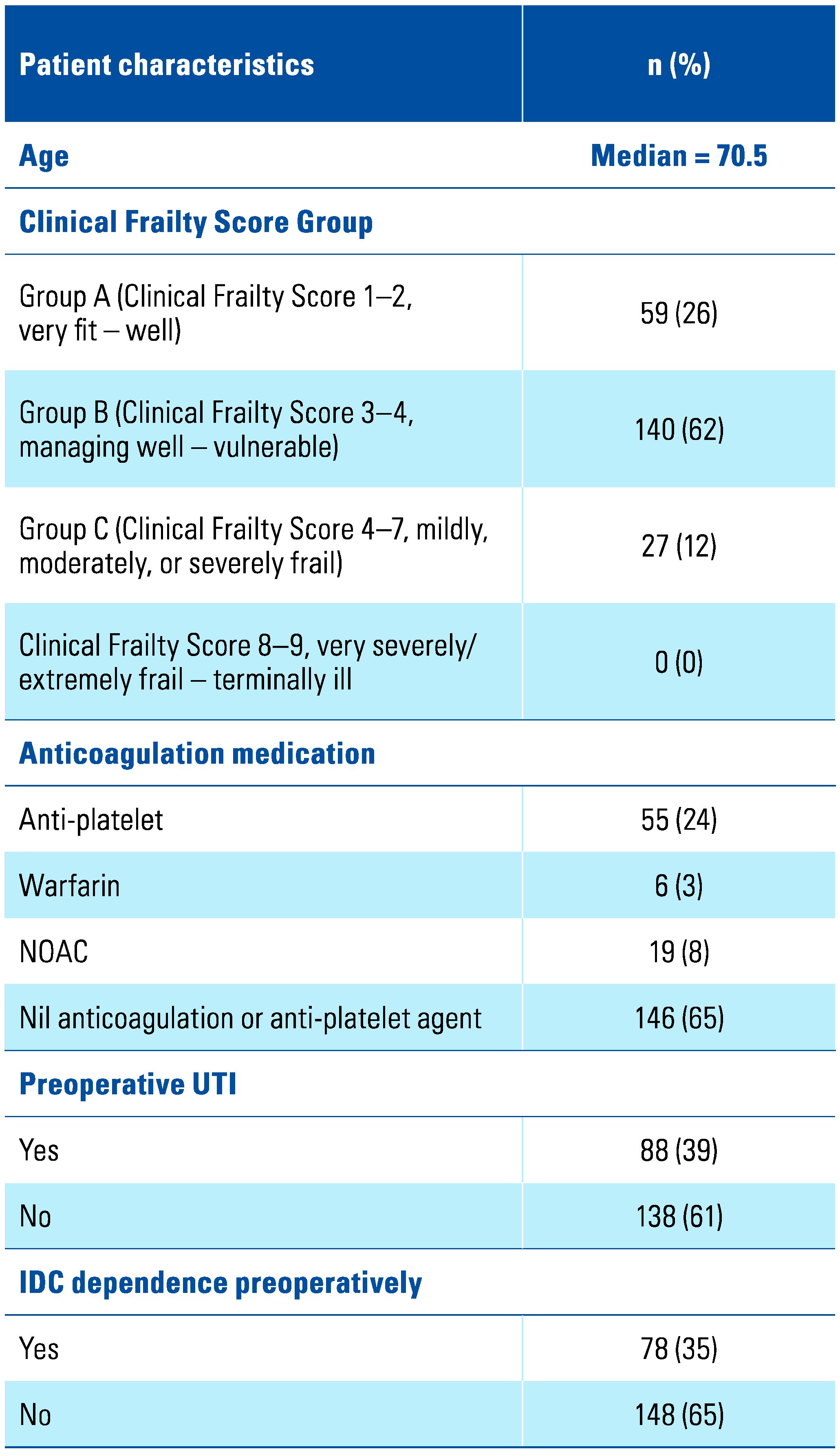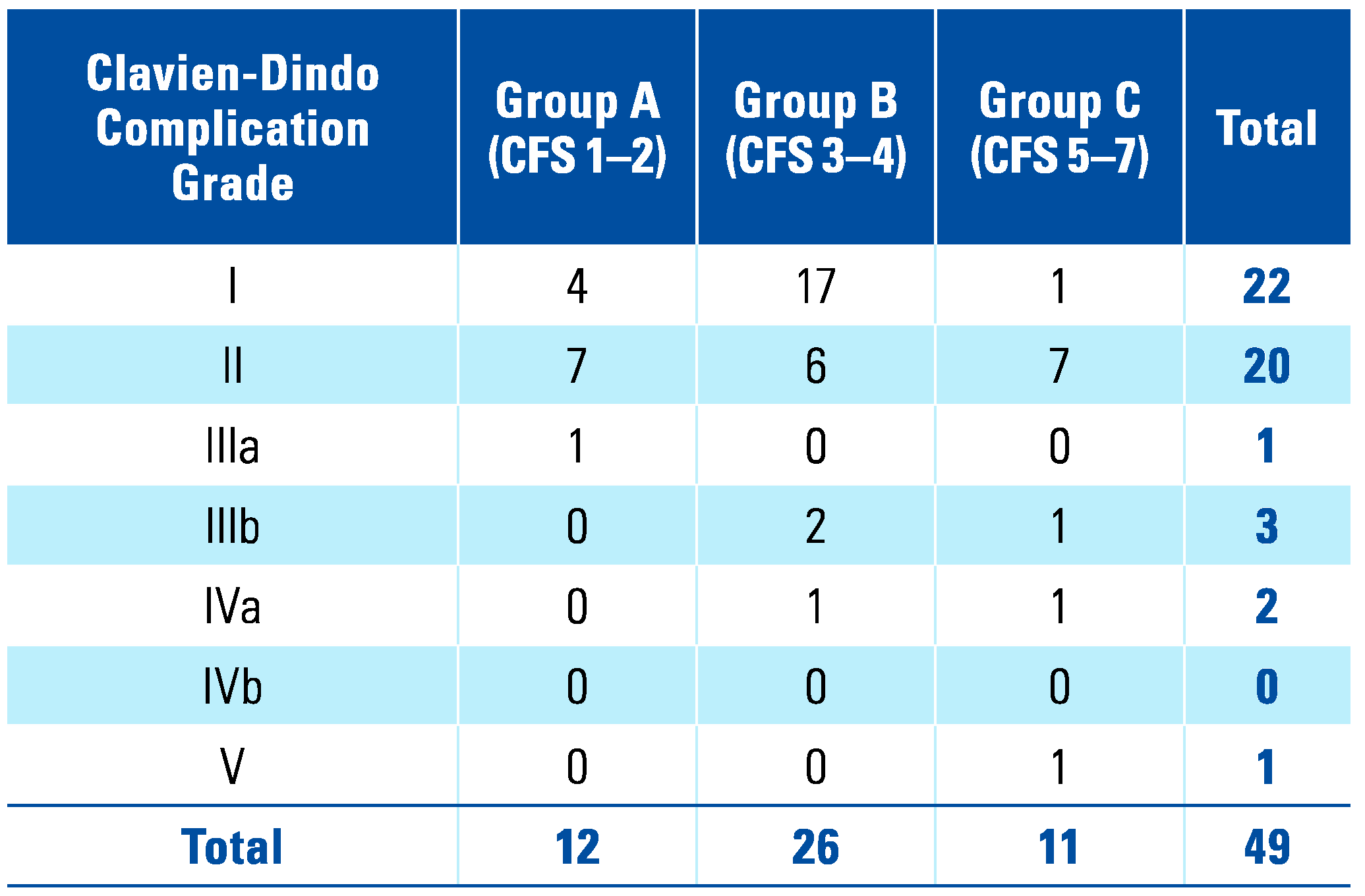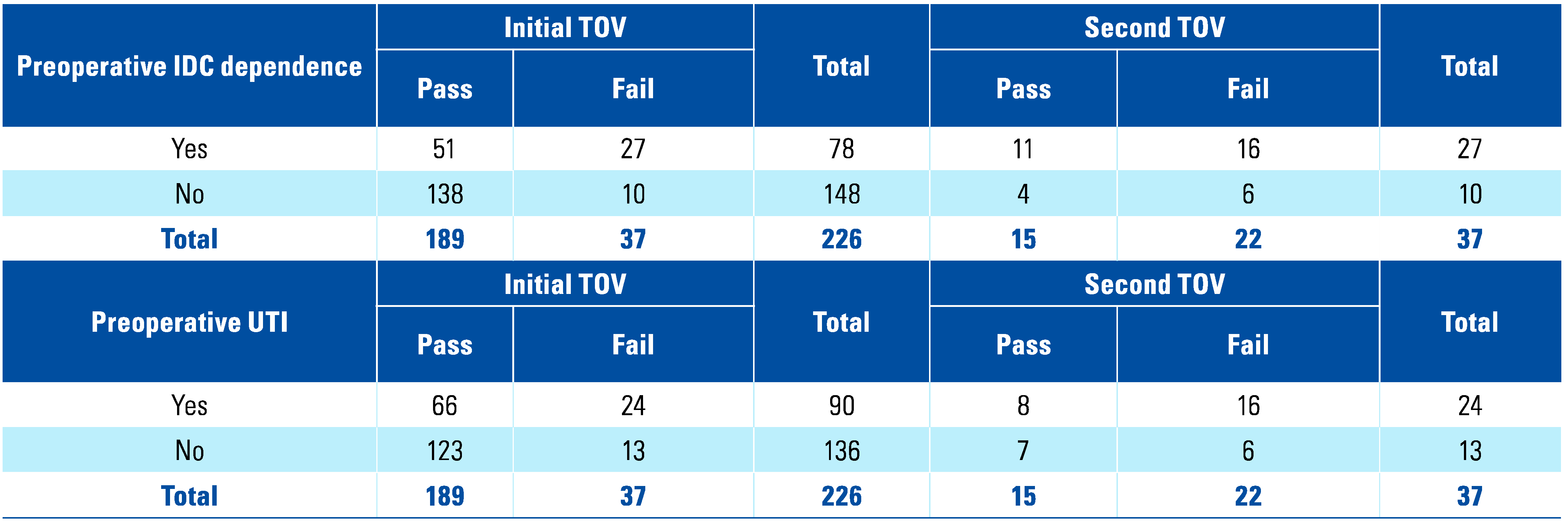Abstract
Background: With the growing elderly population, there is an increasing prevalence of frail patients undergoing surgeries. A common operation in this group is the transurethral resection of prostate (TURP) for the treatment of benign prostatic hyperplasia. Whilst there is a demonstrable link between frailty and general adverse postoperative outcomes, there is limited research on frailty and trial of void (TOV) outcomes post TURP. This study aims to investigate possible associations between frailty, TOV outcomes, and postoperative complications following a TURP. Methods: A retrospective review was conducted of adult patients treated with TURP at 2 hospitals from January 2018 to December 2019, inclusive. Patient demographic data, preoperative Clinical Frailty Scale scores, trial of void outcomes, and complications were recorded and analysed. Clinical frailty scores (CFS) were recorded in accordance with the Dalhousie University Clinical Frailty Scale, ranging from 1 (very fit) to 9 (terminally ill). Results: A total of 226 patients (median age 70.5 years) were identified for this study. Of these patients, 59 were identified as having a CFS of 1 to 2 (Group A), 140 patients had a CFS of 3 to 4 (Group B), and 27 patients had a CFS of 5 to 7 (Group C). Within the initial TOV, Group C had a statistically significant difference in failure rates compared with the other 2 groups, with Group C having the highest failure rate of 33.3% (9/27), followed by Group B with 14.3% (20/140), and then Group A with 13.6 % (8/59) (P = 0.04). Conclusion: In conclusion, greater preoperative frailty is associated with higher rates of initial TOV failure in post-TURP patients. Early objective identification of elderly patients with increased frailty is useful to help preoperative counselling and decision-making, to manage patient postoperative expectations, and to optimise patient care.
Introduction
Frailty is a condition generally characterised by a state of increased vulnerability to external stressors due to age and disease-related deficits. As multiple physiological systems deteriorate with increasing age, the likelihood and prevalence of frailty increases[1,2]. Whilst there is no universal measurement tool to classify frailty, the Clinical Frailty Scale (Figure 1) developed by Rockwood et al., is a validated and commonly used frailty measurement tool with clear descriptors used for summarising the fitness or frailty of patients, when evaluated by experienced clinicians[3].
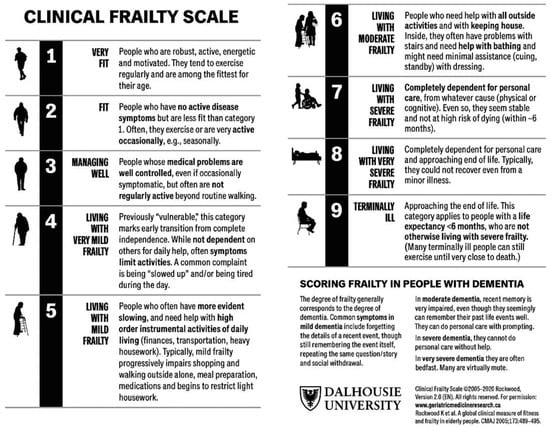
Figure 1.
Clinical Frailty Scale, The Clinical Frailty Scale Version 2.0 by Rockwood K, et al. To apply the Clinical Frailty Scale, the assessor judges the degree of a patient’s frailty based on information gathered from a formal clinical assessment after considering their cognition, mobility, comorbidities, and functional capabilities to assign a frailty score from 1 (very fit) to 9 (terminally ill) [3].
With the increasing elderly population, there has also been an increasing number of frail patients presenting for surgery with a consequent increase in adverse post-operative outcomes[4]. One prevalent condition amongst older men that often requires surgery is bladder outlet obstruction (BOO) secondary to benign prostatic hyper-plasia associated with lower urinary tract symptoms (LUTS), which left untreated can have detrimental quality of life implications, particularly in frail men requiring long-term urethral catheterisation due to severe LUTS[5,6].
At present, the endoscopic gold standard surgical treatment for BOO with LUTS is the transurethral resection of prostate (TURP) via electrocautery procedure, whereby a resectoscope is used endoscopically to remove prostate tissue to unobstruct the outflow tract, improve trial of void (TOV) outcomes, and reduce urethral indwelling catheter (IDC) dependence[7]. Whilst there have been studies demonstrating a link between preoperative frailty and poor baseline functional status with general adverse post urological operative outcomes[8,9,10,11], only one small study of 54 patients conducted by Eredics et al.[9], has assessed preoperative frailty and post-TURP TOV and catheter dependence outcomes. Nonetheless, this study employed a prior version of the Clinical Frailty Scale by Rockwood et al.[12] and did not discern a statistically significant difference in post-TURP catheterisation rates between frail and otherwise well patients.
This study aims to investigate possible associations between preoperative frailty, TOV outcomes, and TURP complications.
Methods
A retrospective cohort study was conducted on men who underwent a TURP followed by TOV at either Royal North Shore Hospital (Sydney, Australia) or The Canberra Hospital (Canberra, Australia) between 1 January 2018 and 31 December 2019. Ethical approval was obtained from the Northern Sydney Local Health District Human Research Ethics Committee (2020/ETH00424). Patient records were examined following these eligibility criteria.
Inclusion criteria
- Adult male patients aged 18 years and above.
- Patients who underwent elective monopolar or bipolar transurethral resection of prostate surgery for bladder outlet obstruction secondary to benign prostatic hyperplasia related lower urinary tract symptoms.
Exclusion criteria
- Patients with a previous diagnosis of neurogenic bladder.
- Patients with a concurrent diagnosis of lower urinary tract pathology, including urethral strictures. Patients who had previous radiotherapy for prostate cancer.
- Patients with a history of previous bladder surgery, including ureteric implantation such as from renal transplants.
- Patients with a history of previous TURP surgery.
Study patients were identified through theatre scheduling lists. Following identification of eligible patients, patient records were reviewed for patient demographics, investigative test results, preoperative plans, operative records, and postoperative outcomes. Data collected pertained to patient demographics, indication for surgical management, preoperative Clinical Frailty Scale scores, trial of void outcomes, and perioperative outcomes with a particular focus on complications. In this study, documentation from pre-admission assessment clinics was reviewed by the authors to retrospectively assign clinical frailty scores (CFS) in accordance with the Clinical Frailty Scale, ranging from 1 (very fit) to 9 (terminally ill)[3]. All patients in this study attended a pre-admission clinic before their TURP procedure, where they were reviewed by a urology intern or resident, anaesthetist, and urology clinical nurse educator. During these clinics, patient comorbidities, regular medications, social history, and functional statuses were recorded by the urology team and anaesthetist. Patient cognition was assessed based upon nursing notes and the patient recommendation for admission booklet completed by patients prior to surgery.
A successful trial of void was based on the Australian New South Wales Agency for Clinical Innovation guideline definition, as the complete bladder emptying with no or minimal post-void residual (PVR) over at least 3 consecutive voids. A sufficient void was defined as either a PVR volume of < 300mL, or a PVR volume less than the voided volume[13]. Complications were categorised according to the Clavien-Dindo grading system[14]. The timing for subsequent TOV attempts for patients who were unsuccessful in their initial TOV were judged clinically on a case-by-case basis.
De-identified data were securely stored in a password protected database within the hospital network to ensure patient privacy and confidentiality. A total of 226 patients were recruited, and their individual data were analysed for this study. Data was analysed using IBM SPSS V27. Descriptive analyses were performed. Normally distributed data were analysed using independent t-tests and ANOVA where appropriate, whilst categorical variables were analysed using chi-square and Fisher’s exact tests as appropriate. P-values < 0.05 were considered significant.
Results
A total of 226 patients were recruited for the study (117 from Royal North Shore Hospital and 109 from The Canberra Hospital), with a median age of 70.5 (mean age of 78.1 years, range 46 to 92 years). Of these, 59 patients (26%) were identified as having a CFS of 1 to 2 (very fit – well, Group A), 140 patients (62%) had a CFS of 3 to 4 (managing well – vulnerable, Group B), and 27 patients (12%) had a CFS of 5 to 7 (mildly, moderately, or severely frail, Group C). No patients were identified as having a frailty score of 8 to 9 (very severe/extremely frail – terminally ill). Fifty-five patients were on anti-platelet agents, 25 were on anticoagulation, and 146 patients were not on any form of anticoagulation or anti-platelet agent (Table 1).

Table 1.
Baseline patient characteristics (n = 226).
Before TURP, 78 patients (35%) were IDC dependent. Preoperatively, 88 patients (39%) had evidence of urinary tract infections (UTIs) (assessed by positive urine culture results), with most of the infections attributed to mixed growth (39% of all infections), Staphylococci (9%), and Enterococci species (9%). Other gram-negative urinary organisms (Pseudomonas, Klebsiella, Escherichia coli, Citrobacter, Proteus and Serratia species) accounted for 34% of the urinary pathogens, with the remaining infections attributed to atypical organisms. Of the 78 patients who were IDC dependent pre-TURP, 63 (81%) had a preoperative UTI, whilst only 25 of the 148 patients (17%) without an IDC preoperatively, had evidence of a UTI on urine culture.
The average length of stay post TURP was 3 days (median stay 2 days, range 1 to 42 days). A total of 189 patients (84%) passed their initial trial of void and of the remaining 37 patients, 15 of them passed on their second trial of void. Twenty-two patients (10%) of patients were unable to pass either trial of void.
Overall, 49 patients experienced a postoperative complication within 30 days of TURP, including hospital readmission, urinary retention, haematuria/clot retention, UTIs/urosepsis, deep venous thrombosis, and death. The majority of these complications were Clavien-Dindo grade I and II, with 22 and 20 patients, respectively (Table 2). There was one mortality in a patient who had a Clinical Frailty Scale score of 7.

Table 2.
Post-TURP complications.
Frail patients were found to be more likely to have preoperative UTIs with positive urine culture results (Group A = 23/59 (39%); Group B = 48/140 (34%); Group C = 17/27 (63%), P = 0.02). Increasing frailty was not significantly associated with IDC dependence preoperatively (Group A = 20/59 (34%); Group B = 46/140 (33%); Group C = 12/27 (44%), P = 0.51).
Upon analysis of the initial TOV, there was a statistically significant difference in failure rates when comparing Group C to the other groups (OR: 3.054; 95% CI 1.248 to 7.469), with Group C having the highest failure rate of 33.3% (9/27), followed by Group B with 14.3% (20/140), and then Group A with 13.6% (8/59) (P = 0.04) (Figure 2). There was no significant difference in initial TOV failure rates between patients in Group A and Group B (P = 0.89). Of the small number of patients who underwent a second TOV, no significant difference in TOV success was observed amongst the different CFS groups (P = 0.09). Patients who had a pre-TURP UTI (OR: 3.441; 95% CI 1.644 to 7.199, P < 0.001) or were catheter dependent preoperatively (OR: 7.253; 95% CI 3.280 to 16.039, P < 0.001) were less likely to pass their initial TOV, but there was no significant difference observed during repeat TOV attempts (Table 3).
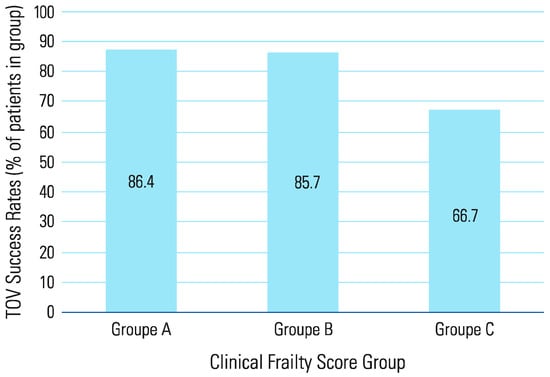
Figure 2.
Clinical Frailty Score Groups and Initial Trial of Void Success Rates.

Table 3.
TOV outcomes and preoperative IDC dependence and UTIs.
Increasing CFS groups (P < 0.001) and initial TOV failures (P < 0.001) were also found to significantly extend postoperative length of stay. There was no significant relationship between preoperative IDC dependence and postoperative length of stay (P = 0.06).
No significant association was found between frailty groups and the rate or severity of complications (P = 0.06). Neither preoperative UTI presence, nor preoperative anticoagulation or anti-platelet use had any correlation with post-TURP complication rates or severity.
Discussion
This study presents a cohort of patients presenting for elective surgical management of their BOO with severe LUTS within the public health care system. The age, prevalence of preoperative IDC dependence, presence of preoperative UTIs, and complication rates of patients in this study were consistent with known epidemiological data for patients undergoing TURP procedures[15,16,17,18,19]. Records pertaining to preoperative PVRs, prostate size, and IPSS were incomplete and therefore were not reported in this study.
Whilst the Clinical Frailty Scale is well validated and simple to apply to patients, an unfortunate shortcoming of the use of the scale in this study, is that an element of clinical judgement is required to grade the degree of frailty for patients, which may impart an element of subjectivity. However, Rockwood, et al. have developed the current Clinical Frailty Scale to provide grading judgements based on descriptive screening criteria focusing on activities of daily living that are readily observed without specialist training and reduce the possibility of subjectivity and bias with results[3].
Within this study, no extremely frail (CFS 8) or terminally ill (CFS 9) patients were identified. This is likely reflective of current preoperative planning and screening processes, whereby such patients are deemed inappropriate for TURP operations during preoperative consultations between the surgeon, the anaesthetist, and the patients and their families, and alternative BOO management options pursued[20]. Similarly, whilst many patients in this study may have had an indication for anticoagulation, a systematic review by Oqab et al., found that frail patients were commonly not prescribed anticoagulation medications because of the concern for cognitive impairment with medication compliance and haemorrhage with increased falls risks, and this may be part of the reason anti-platelet and anticoagulation use were not associated with complications in this study[21].
Frailer patients in this study were found to have increasing preoperative UTI prevalence, which is consistent with known literature[3,22,23]. Increasing frailty in this cohort of patients was not associated with preoperative IDC dependence; however, it is noted that Group C had a higher proportion of patients with preoperative IDC dependence. This is again likely reflecting a preoperative planning process in which frailer patients who were IDC dependent or those who had a concurrent diagnosis of neurogenic bladder were deemed not suitable surgical candidates for TURP and thus not included as patients in this study, whilst healthier patients who were IDC dependent underwent the TURP procedure with the aim of improving their quality of life[24]. There was a higher prevalence of preoperative UTIs in patients who were IDC dependent, because of chronic colonisation of the IDC with biofilms with progression to bacterial infection[25]. This, however, was not associated with postoperative complications, because of the preoperative screening protocols implemented to exchange colonised IDCs and treat any present UTIs preoperatively. Unsurprisingly, preoperative UTI presence and IDC dependence were related to lower initial postoperative TOV success rates[26].
The main focus of this study was to assess the use of the Clinical Frailty Scale as a predictor of TOV outcomes in patients undergoing TURP, with evidence from this study demonstrating that frail patients such as those in Group C were almost 2.5 times more likely to fail their initial post-TURP TOV attempts than rates reported in the literature (33.3% vs. 13.7%)[27]. This is a matter of concern to the health care system as frailer patients and those who fail their initial TOV postoperatively inevitably have a longer hospital admission and place pressure on the limited resources of the health care system as shown in this study. With the implementation of the Clinical Frailty Scale, the frailer population undergoing TURPs can be screened and identified in a multidisciplinary preoperative assessment clinic and have appropriate physician and allied health referrals made to optimise their comorbidities, counsel patient expectations, and streamline patient discharge planning[28,29]. Examples of this include additional catheter care education, and pre-booking community home nursing and outpatient follow-up for patients who require extended periods of catheterisation and who are discharged home with indwelling catheters. Similarly, frail patients identified in this manner, should also receive additional counselling regarding the need for subsequent TOV attempts and on additional treatment options for their BOO, such as concurrent suprapubic catheter insertion with their TURP procedure, promoting shared patient decision-making opportunities.
Whilst no clinically significant difference was found between CFS and repeat TOV success, the number of patients in this study who underwent a repeat TOV was limited at only 37 patients, 15 of whom (40%) passed on their second TOV attempt. With this small sample size, patient factors in this study such as CFS, preoperative UTI presence or IDC dependence, as well as other known causes for post-prostatic surgery urinary retention, such as preoperative PVR or prostate size[30], could not be assessed in significant detail. Further studies with larger patient sample sizes are therefore required to assess if there is an association between increasing frailty and subsequent TOV attempts post TURP.
In this study the majority of TURP complications were Clavien-Dindo grade I-II and could generally be managed on an outpatient basis or on the ward. Whilst no significant association was found between frailty groups and complication rates or complication severity, there was one mortality in a patient with a CFS of 7. Further validation studies are therefore required to assess the possible associations between patients with higher CFS scores and complications post TURP.
This retrospective study demonstrated a correlation between increasing frailty and reduced TOV success post electrocautery TURP. However, it is recognised that this study does not include patients who underwent operations in the private health care setting, patients who underwent laser ablative or vaporisation procedures, or particularly frail patients, such as those with a CFS of 8 or 9. Similarly, this study was unable to comment upon the effect of preoperative PVR, prostate size, or IPSS upon TOV success. Therefore, additional studies on how frail patients should be screened in these settings, and the effect these factors this will have on post-TURP TOV outcomes and patient outcomes is required.
Conclusion
In conclusion, patients assessed as having greater pre-operative frailty are an increased risk of TOV failure and prolonged hospital length of stay post TURP. Therefore, we advocate for the increased use of the Clinical Frailty Scale as a means for identifying elderly preoperative TURP patients with increased frailty to establish early preoperative counselling, referrals, and decision-making, to optimise patient postoperative expectations and perioperative care.
Acknowledgments
Competing Interests: Dr Amanda Chung: Proctor for Medtronic and Boston Scientific.
The other authors do not have any competing interests to declare.
Abbreviations
| BOO | Bladder outlet obstruction |
| CFS | Clinical Frailty Scale |
| IDC | Indwelling catheter |
| IPSS | International Prostate Symptom Score |
| LUTS | Lower urinary tract symptoms |
| PVR | Post-void residual |
| TOV | Trial of void |
| TURP | Transurethral resection of prostate |
References
- Lang, P.-O.; Michel, J.-P.; Zekry, D. Frailty syndrome: A transitional state in a dynamic process. Gerontology 2009, 55, 539–549. [Google Scholar] [CrossRef] [PubMed]
- Dasgupta, M.; Rolfson, D.B.; Stolee, P.; Borrie, M.J.; Speechley, M. Frailty is associated with postoperative complications in older adults with medical problems. Arch. Gerontol. Geriatr. 2009, 48, 78–83. [Google Scholar] [CrossRef] [PubMed]
- Rockwood, K.; Theou, O. Using the clinical frailty scale in allocating scarce health care resources. Can. Geriatr. J. 2020, 23, 210. [Google Scholar] [CrossRef] [PubMed]
- Lin, H.-S.; Watts, J.; Peel, N.; Hubbard, R. Frailty and post-operative outcomes in older surgical patients: A systematic review. BMC Geriatr. 2016, 16, 1–12. [Google Scholar] [CrossRef] [PubMed]
- Lim, K.B. Epidemiology of clinical benign prostatic hyperplasia. Asian J. Urol. 2017, 4, 148–151. [Google Scholar] [CrossRef] [PubMed]
- Ravindrarajah, R.; Lee, D.M.; Pye, S.R.; Gielen, E.; Boonen, S.; Vanderschueren, D.; et al. The ability of three different models of frailty to predict all-cause mortality: Results from the European Male Aging Study (EMAS). Arch. Gerontol. Geriatr. 2013, 57, 360–368. [Google Scholar] [CrossRef] [PubMed]
- Yu, J.; Jeong, B.C.; Jeon, S.S.; Lee, S.W.; Lee, K.-S. Comparison of efficacy of different surgical techniques for benign prostatic obstruction. Int. Neurourol. J. 2021, 25, 252. [Google Scholar] [CrossRef] [PubMed]
- Dent, E.; Lien, C.; Lim, W.S.; Wong, W.C.; Wong, C.H.; Ng, T.P.; et al. The Asia-Pacific clinical practice guidelines for the management of frailty. J. Am. Med. Dir. Assoc. 2017, 18, 564–575. [Google Scholar] [CrossRef] [PubMed]
- Eredics, K.; Meyer, C.; Gschliesser, T.; Lodeta, B.; Heissler, O.; Kunit, T.; et al. Can a simple geriatric assessment predict the outcome of TURP? Urol. Int. 2020, 104, 367–372. [Google Scholar] [CrossRef]
- Makary, M.A.; Segev, D.L.; Pronovost, P.J.; Syin, D.; Bandeen-Roche, K.; Patel, P.; et al. Frailty as a predictor of surgical outcomes in older patients. J. Am. Coll. Surg. 2010, 210, 901–908. [Google Scholar] [CrossRef]
- Suskind, A.M.; Walter, L.C.; Zhao, S.; Finlayson, E. Functional outcomes after transurethral resection of the prostate in nursing home residents. J. Am. Geriatr. Soc. 2017, 65, 699–703. [Google Scholar] [CrossRef] [PubMed]
- Rockwood, K.; Song, X.; MacKnight, C.; Bergman, H.; Hogan, D.B.; McDowell, I.; et al. A global clinical measure of fitness and frailty in elderly people. CMAJ 2005, 173, 489–495. [Google Scholar] [CrossRef] [PubMed]
- NSW Agency for Clinical Innovation. Clinical Guidelines, Urology, Trial of Void - Hospital - Clinical Guideline: NSW Government; 2010. Available online: https://aci.health.nsw.gov.au/__data/assets/pdf_file/0007/191068/ACI_TOV_Hospital_Jan13.pdf (accessed on 10 August 2023).
- Dindo, D.; Demartines, N.; Clavien, P.-A. Classification of surgical complications: A new proposal with evaluation in a cohort of 6336 patients and results of a survey. Ann Surg. 2004, 240, 205–213. [Google Scholar] [CrossRef] [PubMed]
- Black, B.; English, S. Is TURP safe with room temperature irrigation? A randomised control trial. J. Urol. 2019, 201 (Suppl 4), e643. [Google Scholar] [CrossRef]
- Culkin, D.J.; Exaire, E.J.; Green, D.; Soloway, M.S.; Gross, A.J.; Desai, M.R.; et al. Anticoagulation and antiplatelet therapy in urological practice: ICUD/AUA review paper. J. Urol. 2014, 192, 1026–34. [Google Scholar] [CrossRef] [PubMed]
- Srinivasrao, P.; Shashidhar, M. Bipolar versus monopolar transurethral resection for benign prostatic hypertrophy: A prospective comparative study. Int. Surg. J. 2022, 9, 1016–1018. [Google Scholar] [CrossRef]
- Tamalunas, A.; Westhofen, T.; Schott, M.; Keller, P.; Atzler, M.; Stief, C.G.; et al. The impact of preoperative lower urinary tract symptoms medication on the functional performance of holmium laser enucleation of the prostate. Cent. European J. Urol. 2021, 74, 429–436. [Google Scholar] [CrossRef] [PubMed]
- Wada, N.; Kikuchi, D.; Tateoka, J.; Abe, N.; Banjo, H.; Tsuchida, M.; et al. Long-term symptomatic outcome after transurethral resection of the prostate: A urodynamics-based assessment. Int. J. Urol. 2019, 26, 1071–1075. [Google Scholar] [CrossRef] [PubMed]
- Richards, S.J.; Frizelle, F.A.; Geddes, J.A.; Eglinton, T.W.; Hampton, M.B. Frailty in surgical patients. Int. J. Colorectal Dis. 2018, 33, 1657–1666. [Google Scholar] [CrossRef]
- Oqab, Z.; Pournazari, P.; Sheldon, R.S. What is the impact of frailty on prescription of anticoagulation in elderly patients with atrial fibrillation? A systematic review and meta-analysis. J. Atr. Fibrillation 2018, 10, 1870. [Google Scholar] [CrossRef]
- Chao, C.-T.; Lee, S.-Y.; Wang, J.; Chien, K.-L.; Huang, J.-W. Frailty increases the risk for developing urinary tract infection among 79,887 patients with diabetic mellitus and chronic kidney disease. BMC Geriatr. 2021, 21, 349. [Google Scholar] [CrossRef] [PubMed]
- Kostakopoulos, N.A.; Karakousis, N.D.; Moschotzopoulos, D. Frailty associated urinary tract infections (FaUTIs). J. Frailty Sarcopenia Falls 2021, 6, 9–13. [Google Scholar] [CrossRef] [PubMed]
- Patel, D.N.; Alabastro, C.G.; Anger, J.T. Prevalence and cost of catheters to manage neurogenic bladder. Curr. Bladder Dysfunct. Rep. 2018, 13, 215–223. [Google Scholar] [CrossRef]
- Roth, J.D.; Pariser, J.J.; Stoffel, J.T.; Lenherr, S.M.; Myers, J.B.; Welk, B.; et al. Patient subjective assessment of urinary tract infection frequency and severity is associated with bladder management method in spinal cord injury. Spinal Cord. 2019, 57, 700–707. [Google Scholar] [CrossRef] [PubMed]
- McKinnon, A.; Higgins, A.; Lopez, J.; Chaboyer, W. Predictors of acute urinary retention after transurethral resection of the prostate: A retrospective chart audit. Urol. Nurs. 2011, 31, 207–212. [Google Scholar] [CrossRef] [PubMed]
- Zhang, Z.; Liang, C.Z.; Li, G.Y.; Lin, C.M.; Zhang, X.M.; Gu, H.B.; et al. Causes of and risk factors for failure in catheter removal after transurethral resection of the prostate [Article in Chinese]. Zhonghua Nan Ke Xue 2020, 26, 250–253. [Google Scholar]
- Bierle, D.M.; Raslau, D.; Regan, D.W.; Sundsted, K.K.; Mauck, K.F. Preoperative evaluation before noncardiac surgery. Mayo Clin. Proc. 2020, 95, 807–822. [Google Scholar] [CrossRef] [PubMed]
- Dhesi, J.; Swart, M. Specialist pre-operative assessment clinics. Anaesthesia 2016, 71, 3–8. [Google Scholar] [CrossRef]
- Elmansy, H.; Shabana, W.; Ahmad, A.; Hodhod, A.; Hadi, R.A.; Tablowski, T.; et al. Factors Predicting Successful Same-Day Trial of Void (TOV) After Laser Vaporization of the Prostate. Urology 2022. [Google Scholar] [CrossRef]
This is an open access article under the terms of a license that permits non-commercial use, provided the original work is properly cited. © 2023 The Authors. Société Internationale d'Urologie Journal, published by the Société Internationale d'Urologie, Canada.
